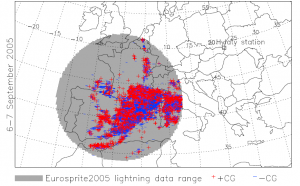Cloud‐to‐ground lightning dipole moment from simultaneous observations by ELF receiver and combined direction finding and time‐of‐arrival lightning detection system
JOURNAL OF GEOPHYSICAL RESEARCH
VOL. 116, D08107, 9 PP., 2011
Z. Nieckarz 1), A. Kułak 2), S. Zięba 2), and A. Odzimek 3)
1) Institute of Physics, Jagiellonian University, Krakow, Poland
2) Astronomical Observatory, Jagiellonian University, Krakow, Poland
3) Department of Physics and Astronomy, University of Leicester, Leicester, UK
Download: http://europa.agu.org/
Citation: (2011), Cloud‐to‐ground lightning dipole moment from simultaneous observations by ELF receiver and combined direction finding and time‐of‐arrival lightning detection system, J. Geophys. Res., 116, D08107, doi:10.1029/2010JD014736.
Abstract
We present a new method of automatic detection of ELF impulses related to cloud‐to‐ground lightning at distances 1–2 Mm from a broadband ELF receiver and also we present a new numerical automated technique for calculating the lightning dipole moment. We have performed the detection for two known data sets of lightning flashes detected by the French lightning detection network Meteorage in southwest Europe over two 48 h periods 28–29 July and 6–7 September 2005. The number of flashes identified in the ELF data compared to the number of flashes detected by Meteorage reach 10–25% when little local activity close to the ELF station is present. The local thunderstorm activity worsens the detection of lightning from larger distances and the efficiency of identification of ELF impulses as lightning can decrease to a few percent. By combining the information on the location of the lightning flashes from Meteorage with the ELF data, lightning dipole moments can be calculated. Our results suggest the dipole moment is linearly correlated with the lightning peak current (p≈ 7.5 Imax) but the dispersion of the dipole moment for a given peak current is significant. One of the reasons of such dispersion is the contribution of the lightning continuing current to the ELF signal.
